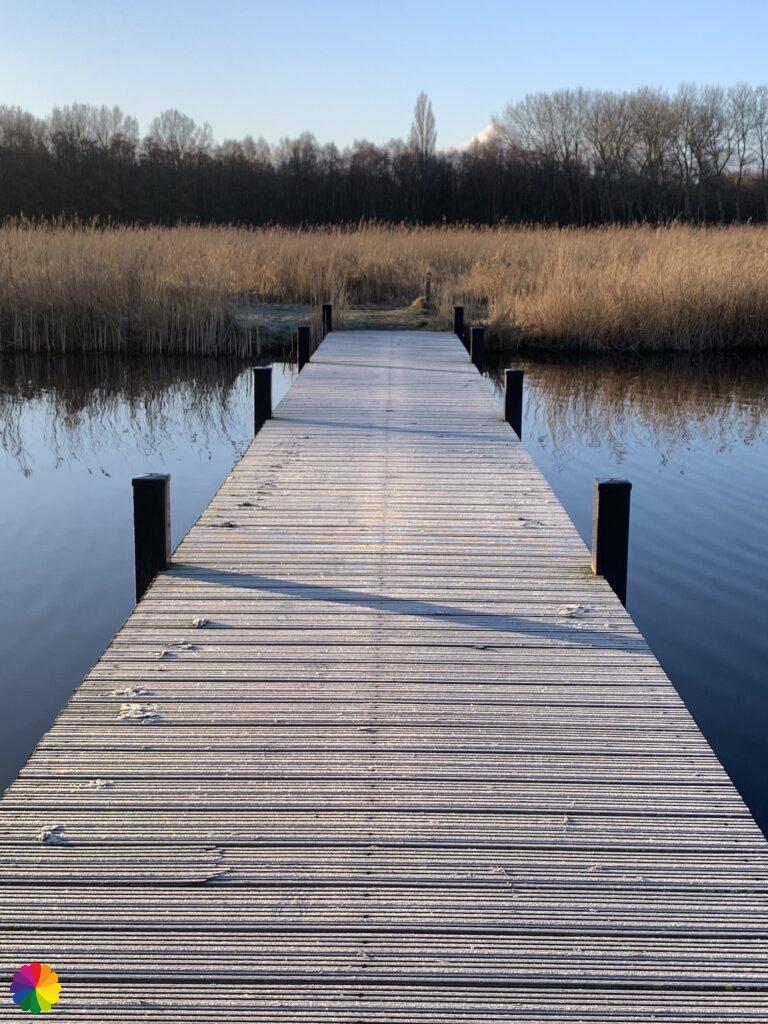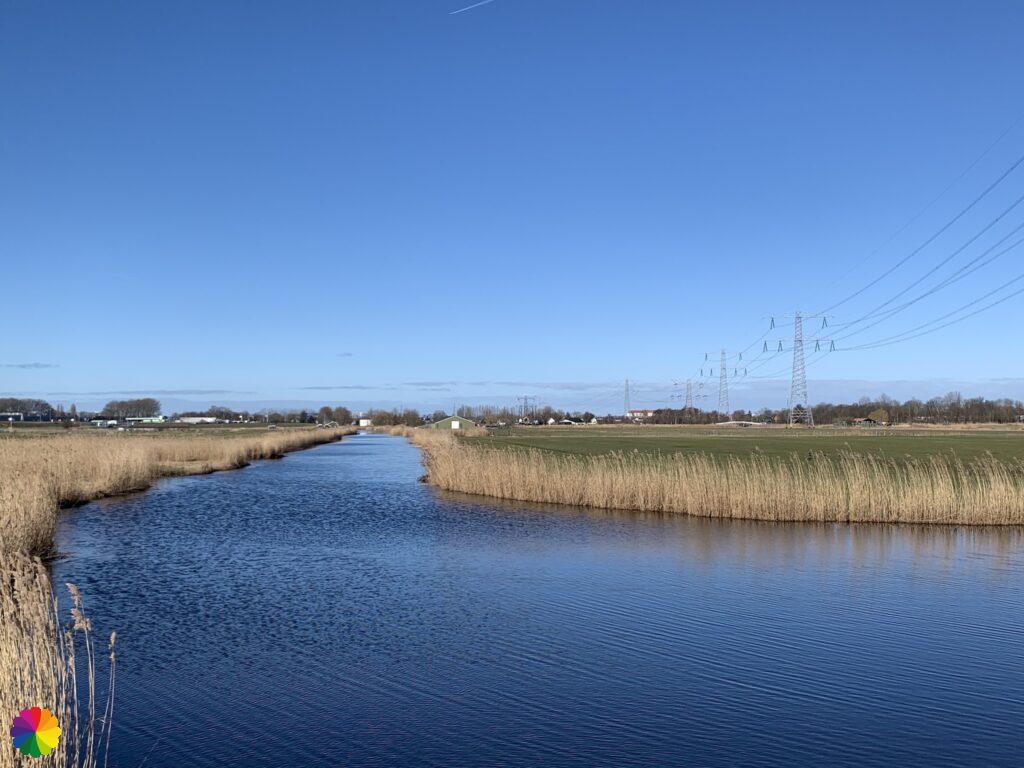After a wonderful hike on the Migration birds trail between Zaanse Schans and Den Ilp last time, I really got the hang of it and travelled to Den Ilp a week later. I continue my hike through the Twiske nature and recreational area, walk a bit through Landsmeer, then go through the polders of the Ilperveld and end my hike just after the ferry at Het Schouw.
At the east side of the Twiske
Because I enjoyed the previous hike on the Migration birds trail so much, I am already back a week later at the point where I stopped last time. This is near Den Ilp, on the east side of the Twiske nature reserve. Last time, I had already seen a bit of the west and north side.
It is the beginning of March (2021) and it is chilly this morning. There is a beautiful layer of frost over the nature reserve. The sky is clear blue with not a cloud in the sky. The sky contrasts beautifully with the brown and ochre colours of the bushes and reeds. This part of the Twiske looks a bit like the tundra (or so I imagine), with a bit more trees and bushes.


I walk on over winding paths and sometimes I have to cross a boardwalk. I have to be careful, it is slippery! Different species of geese make themselves heard with their cackling. The Egyptian geese are particularly active.


After a while, I reach the beach for swimming and playing. Here I take a coffee break. Behind me, I hear the ticking of a woodpecker in the trees. I cannot find the woodpecker. I continue along the path between the birches. The woodpecker keeps on ticking and suddenly I see some black, white and red flying past. There he is! It is a great spotted woodpecker, recognisable by its red ‘trousers’.
Illustration of great spotted woodpecker will follow later
The middle-spotted woodpecker is the rarest of the species in the Netherlands. They are found mainly in the east and south of the country in old oak forests. This woodpecker is slightly smaller than the great spotted, has only black and white on the wings and a white head, red cap and salmon pink ‘trousers’.
The lesser spotted woodpecker is increasing in number in the Netherlands. They are common in deciduous and mixed woodland with soft wood types. They nest in holes in soft trees, such as birch, willow, alder and poplar. This woodpecker is not much larger than a sparrow. The male is black and white with a red cap, the female has no cap. Their ticking sound like a sewing machine.
Source (in Dutch): Vogelbescherming
I now walk along the Stootersplas. There is a look-out point with a bank swallow wall on the other side. It is still too early in the year for swallows. But I do see a number of cormorants in a row drying their wings. I also come across a group of tufted ducks.



In the checklist below, you can see all the birds I encountered during this hike. It still is and remains the Migration Birds Trail!
| Birds seen between Den Ilp en Het Schouw | |||
|---|---|---|---|
| ✔ Black-headed gull | ✔ Eurasian collared dove | ✔ Gadwall | ✔ Long-tailed tit |
| ✔ Carrion crow | ✔ Eurasian coot | ✔ Great crested grebe | ✔ Mute swan |
| ✔ Common buzzard | ✔ Eurasian jay | ✔ Great spotted woodpecker | ✔ Northern lapwing |
| ✔ Common moorhen | ✔ Eurasian magpie | ✔ Great tit | ✔ Stock dove |
| ✔ Common starling | ✔ Eurasian tree sparrow | ✔ Grey heron | ✔ Tufted duck |
| ✔ Common wood pigeon | ✔ European herring gull | ✔ Greylag goose | ✔ Western great egret |
| ✔ Cormorant | ✔ Eurasian oystercatcher | ✔ House sparrow | ✔ Western jackdaw |
| ✔ Egyptian goose | ✔ European robin | ✔ Mallard | |
The path through the Twiske continues, then to the left, then to the right. Then again, over a short boardwalk path along the lake, then through the woods again. Such a diverse nature reserve! Having arrived at a beach, I momentarily lose the trail markings, but soon I find the red and white markings again.


I leave the Stootersplas behind me. Here, the Twiske looks different again. Many ponds, small bridges and more vegetation, such as reed beds, alders and willows and many berry and blackberry bushes. Highland cattle also graze here. I only see one in the distance.






I get closer and closer to Landsmeer and it also gets a bit busier. I pass through a part of the Twiske with high poplars and grass fields. Then I cross the parking lot of a camping site.
Other trail guide about the same region
Just a little further and I am out of the Twiske. I walk past the Twiskemolen. On this road, it is very busy with other hikers and cyclists.
Landsmeer
After a drawbridge I am in Landsmeer. I turn left and walk along a long row of sports clubs. A little later I reach the main road through Landsmeer and turn right here. It is very busy with cars, I am glad there is a pavement. This is not the nicest part of the trail.
After a bit along the busy road, I cross the road and enter a park on the other side. It is a lot quieter here. In the park, buds are already growing on the trees; spring is coming!


The Ilperveld
Soon, I am out of the park again and walk through the open polder landscape of the Ilperveld. Further on, I can see the A10 motorway with Amsterdam behind it. I walk along the green fields via the cycle path. Now and then, I stand still to study a bird, but it remains difficult to recognise the species.



At a bend in the cycle path, I take a break on a bench. Near the bench, there is a war monument in memory of an aeroplane that crashed in the Second World War. In my opinion, this is the most interesting part of the Ilperveld. The fields begin to look a little boring. This makes it a nice part to walk faster. Soon I reach the residential area again.



After a road with a number of beautiful farms, I end up at the North-Hollandsch canal for the 3rd time on the Migration birds trail. I go to the right and walk along the canal until I reach the ferry. I am allowed to go on board immediately and after a few minutes I am on the other side of the canal. Here I walk another short distance along the canal in the opposite direction and then turn right. At a viaduct, this hike ends for me today. On the viaduct is the busstop Het Schouw, a nice spot to pick up the trail next time.
Final thoughts
This time, the blog post is not very extensive, mainly because the first part through the Twiske was the most interesting. That is why I took a lot of photos and an illustration (follows soon) of this nature reserve. I found the busyness in Landsmeer and the part through the Ilperveld a bit less fun. Despite that, it was still a super hike. So this time a 4 star rating for this part of the trail.
More info:
Trail: Part of Section 4 and Section 5 Long distance trail 2: Migration birds trailWhere: from Den Ilp to Het Schouw, Noord-Holland, the Netherlands.
No. of km: +/- 17 km
Hiking date: 4 March 2021
Materials used in illustrations: coloured pencils for the map and watercolour paints for the other illustrations
Rating: ⭐⭐⭐⭐
The Migration birds trail kept attracting me around that time, so next time, another blog post about this trail through the picturesque villages of Waterland, including a nasty encounter with a goose! Want a sneak preview of the next hike? Then check out my post on Instagram.
Pin this hike
The image to ‘pin’ on Pinterest will be added as soon as the illustrations are ready.
ColourFlux Studio makes use of so-called affiliate links. If you buy a product through the link in an advertisement, ColourFlux Studio receives a small amount. There are no additional costs for the buyer.
Back to Blog






